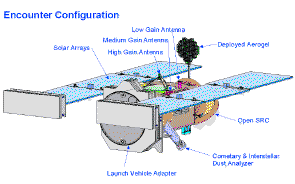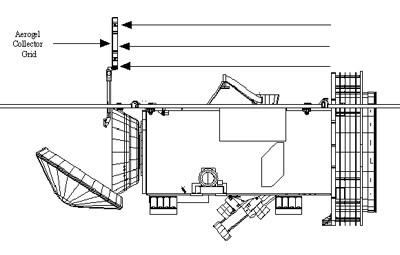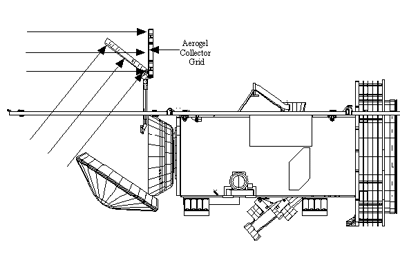Coma and Nucleus Imaging
The raison d'être for STARDUST is its ability
to provide unique new knowledge of comets and
interstellar particles. The mission will also
provide excellent imaging, however, both optical
navigation in support of the dust collection and
for the study of nucleus morphology. The camera
has the ability to investigate the large scale
distribution of dust and associated gases in the
general coma as well as in jets. It also will
permit observation of the areas on the nucleus
which are the source of the dust. There are advantages
in studying a comet somewhat less active than
Halley in that the spacecraft can fly closer to
the nucleus and not be so readily overwhelmed
optically or physically by the outflowing dust.
The imaging results also will determine the size,
shape, and albedo of the nucleus. Close to the
nucleus, STARDUST will provide detailed nucleus
morphology comparable to the Deep Space 1 images
of Comet Borrelly, and 10 times better resolution
than the Giotto pictures of Halley.
A six kilometer nucleus would fill one pixel at
100,000 km, about 4.6 hours before closest approach.
In sum, the slow flyby speed and close nucleus
approach distance of STARDUST provide superior
imaging, beter in resolution and more images than
any prior cometary mission, without in any way
compromising the primary goal of collecting cometary
samples and interstellar dust.
Dust Collection
- Spacecraft Encounter Configuration

Comet Dust Collection
The comet samples will be collected during a 6.1
km/s flyby of Comet Wild 2. At this flyby speed,
coma dust in the 1 to 100 micron size range will
be captured by impact into ultra-low continuous
varying density aerogel. Particle collection at
this speed has been extensively demonstrated in
laboratory simulations and Shuttle flights and
we have shown that the comet dust collection can
be done with minimum amount of sample alteration.
Spacecraft Configuration
for Comet Particle Collection

Interstellar
Dust Collection
Interstellar Dust Capture
Profile
Based on recent studies [3], interstellar particles
are assumed to enter the heliosphere with a velocity
of 30 km/s from the upstream direction of 7.7°±5°,
259°±15° ecliptic latitude and
longitude. The flight paths of the interstellar
dust grains are modified by solar gravity, solar
pressure, electromagnetic interaction with the
interplanetary magnetic field, and various other
complex processes not well or easily formulated.
If one considers only the simple effects of solar
gravity and solar pressure, the velocities of
interstellar dust grains of various sizes can
be calculated as a function of , where is the
ratio of solar pressure to solar gravity.
Interstellar Dust Collection
Strategy
The strategy of interstellar dust collection is
(1) to collect at the part of the spacecraft orbit
where dust impact velocity is relatively low (<25
km/s), (2) to orient the collector in a specific
direction so that the flux for the desired interstellar
dust is maximized, and (3) to avoid pointing toward
the sun in order not to intercept particles. Total
duration of interstellar dust collection will
be about 6 months.
Mission operation during the intersterllar dust
collection period is similar to cruise phase due
the passive nature of the collector design. Although
the interstellar dust collector will need to be
steered in specific directions to maximize the
interceptions of desired interstellar dust grains,
tight attitude control is not required because
the uncertainty in the interstellar dust radiant
direction may be as large as 30°.
Spacecraft Configuration
for Interstellar Particle Collection

Appendix
+
Acronyms
|
